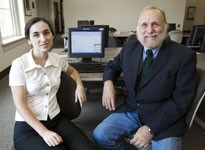
UC Researchers Design Humorous Bot'
University of Cincinnati researchers Julia Taylor and Larry Mazlack recently unveiled a "bot more accurately a software program that recognizes jokes. They reported the development at the American Association for Artificial Intelligence conference in Vancouver, Canada. All bad jokes aside, their research represents a step forward in computers reaching the capability of a human mind.
, a doctoral student under UC Professor Mazlack, is studying data mining the science of deriving meaning from large amounts of data. Mazlack is the coordinator of the
Applied Artificial Intelligence Laboratory
and coordinator of the Data and Knowledge Management research group. Taylor specifically researches humor in robots.
"This work has a relationship to 'Sociable Computing,'" says Mazlack. "Currently, computers are often difficult to communicate with, to use and to apply to solving problems that are informally stated."
This area has been researched for decades and has also been the subject of many Star Trek episodes. Developments such as these offer sophisticated improvements in robots that are used as companions or to otherwise interact directly with humans.
The robot is just a software program that still needs a lot of work, says researcher Taylor. The idea is to be able to recognize jokes that are based on phonological similarity of words.
The program can in fact recognize jokes, but ONLY when the necessary background and world knowledge are provided, she says. The ontology that provides this knowledge is a work-in-progress at this stage. So, the software is far from being finished, but does produce some results.
Taylor had the distinct task of training the computer by providing it with information relative to American English at a childs level. They developed an extensive list of knock-knock jokes that turn on peoples names, particularly.
Further action is required to make this image accessible
One of the below criteria must be satisfied:
- Add image alt tag OR
- Mark image as decorative
The image will not display on the live site until the issue above is resolved.
Knock, Knock
Who is there?
Dawn
Dawn who?
Dawn by the station, early in the morning
Knock, Knock
Who is there?
Wendy
Wendy who?
Wendy last time you took a bath?
Then they gave the bot several examples of words that can have different meanings and homonyms, as in puns. The program then checks to see if the message is consistent with what would make sense. If it doesnt, the bot searches to see if the word sounds similar to a word that would fit. If this is the case, the bot flags it as humor.
Knock, Knock
Who is there?
Dismay
Dismay who?
Dismay not be a funny joke
Even leaden puns are very difficult to understand as well, says Taylor. With the knowledge that is in the ontology right now, there are very, very few jokes (or puns) that the program can understand.
The ability to appreciate humor is an enormous increment in subtlety. You need to know a lot to get humor a computer does not find it easy.
"Part of the difficulty lies with the formality that computers and people need to use to interact with each other," says Mazlack. "A critical aspect in achieving sociable computing is being able to informally communicate in a human language with computers. Computationally handling humor is critical to being able to conduct an informal dialogue with a computer; Julia Taylor is making good progress in advancing knowledge in this area other people in my lab are working on different aspects of less formal ways of using computers."
Knock, Knock
Who is there?
Police
Police who?
Police tell me some Knock Knock jokes
Heres an example of one of the robots favorite jokes:
Mother to boy: Johnny, youve been working in the garden a lot this summer.
Boy: I know. My teacher told me to weed a lot.
Notice that the boy says the teacher told him to WEED. Since weed sounds similar to 'read,' the program can find this wordplay, Taylor says.
Although not quite "where no one has gone before," this research is a giant leap toward approaching the capability of the human mind.
Knock, Knock
Who is there?
Noah
Noah who?
Noah good place to find more jokes?
Related Stories
UC’s Ground Floor Makerspace births combat robots
April 17, 2024
In the heart of UC's 1819 Innovation Hub lies the Ground Floor Makerspace, an advanced and active hub of ingenuity where students, faculty and the community converge to bring their ideas to life. This includes being the birthplace of robots much like miniature race cars, combating fender to fender in an enclosed boxing ring. Combat robots like UC's Maximizer will again be fighting for first place in the National Havoc Robot League (NHRL) competition, slated for April 20.
UC researchers develop new CPAP device
April 17, 2024
Researchers at the University of Cincinnati are developing a VortexPAP machine that takes advantage of vortex airflow technology. A preliminary clinical study with current CPAP users demonstrated that the VortexPAP can deliver the pressure levels that are used in the subjects’ CPAP therapy, but the mask is more comfortable to wear. It has a minimalistic design that is less intrusive and barely touches the patient’s face.
UC architectural engineering alumna inspires high school students
April 16, 2024
University of Cincinnati alumna Emma Wilhelmus fell in love with engineering when she was in ninth grade. After taking drafting, architecture and engineering courses in high school, she set out to major in architectural engineering in college. Now, she is an engineering teacher at a local high school and hopes to inspire students.
